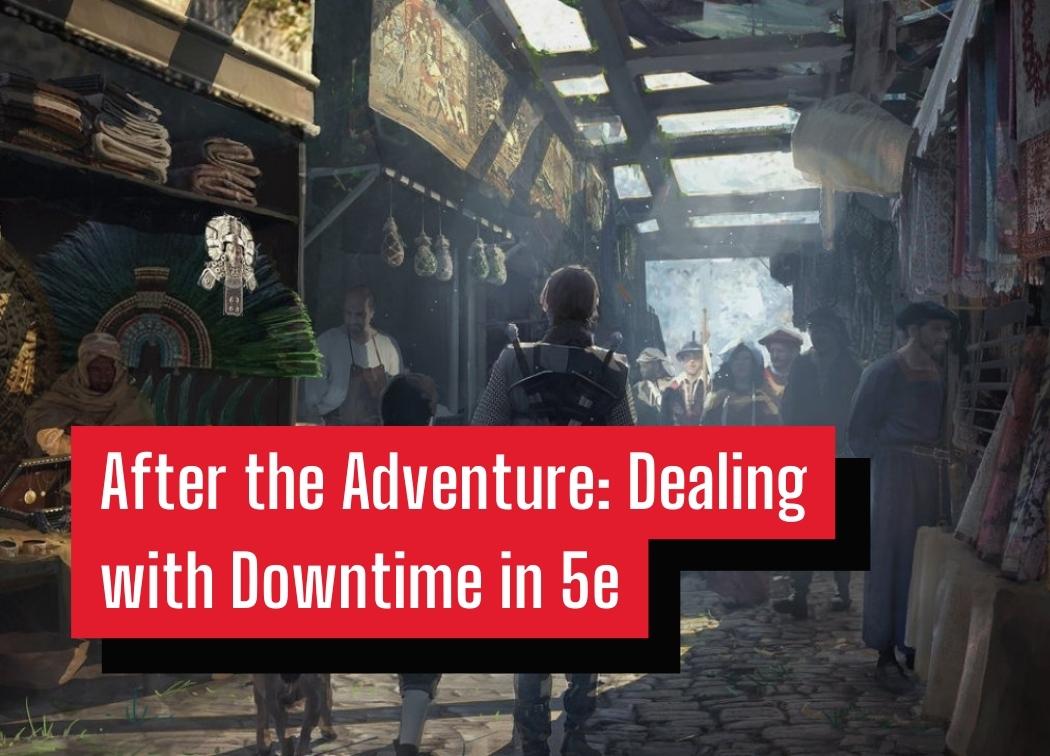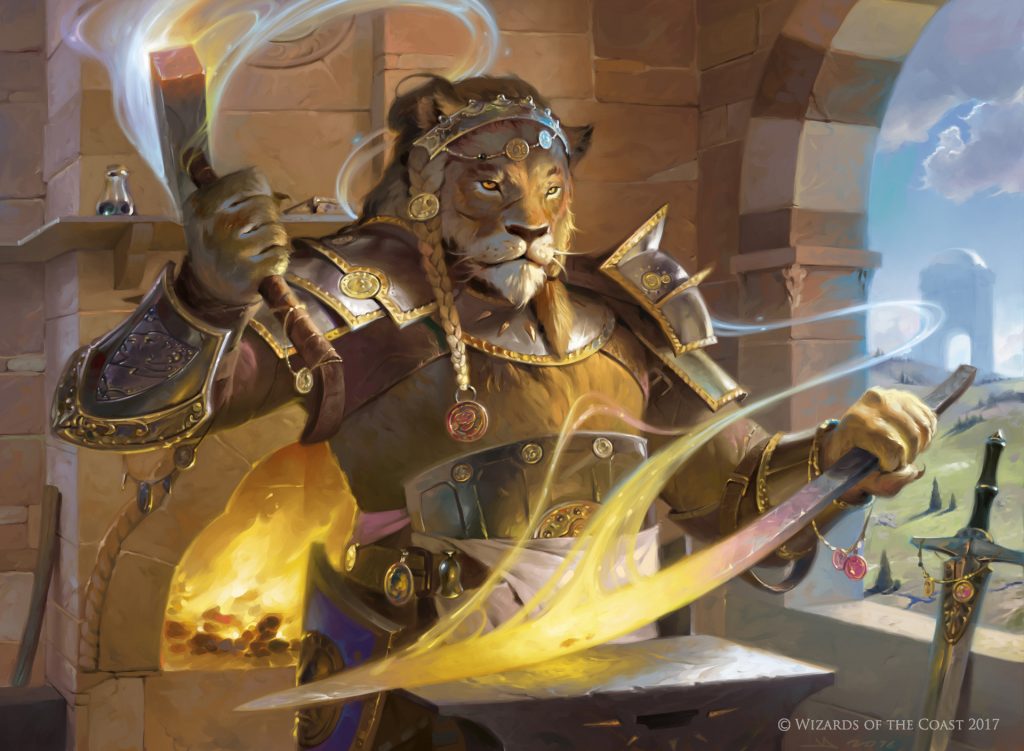After the Adventure: Dealing with Downtime in 5e

I’m a great DM. I have a solid grasp of D&D 5e’s rules and my group has a lot of fun when we play together. However, I’d say that I’ve got plenty of room to grow in terms of story structure. Pacing is certainly my most glaring weakness. However, it’s gotten better since I’ve embraced downtime.
I hadn’t thought much about the lack of pacing in my D&D 5e campaign until I began running our casual Shadow of the Demon Lord campaign. In Shadow of the Demon Lord (SotD) having downtime between each adventure is a legitimate mechanic in the game that everyone needs to be mindful of.
The pacing of the campaign’s story flows a hell of a lot better when you start to throw downtime into the mix. Primarily because the players get a specific portion of time that acts as a transition period between adventures. Everything is sectioned off so it’s easier to visualize days, weeks, months, or even years passing by.
Downtime also gives players a chance to have their characters pursue other interests or activities outside of their adventuring careers. Sure, it gives them a bit of depth, but it’s also a great way to take care of all that extra off-screen bookkeeping while also providing a noticeable gold sink!
So let’s talk about how we can utilize downtime in a way that aids the pacing of our D&D campaigns but also doesn’t take valuable time away from the action!
Cost of Living
In almost all of the games, I DM the party usually posts up in an inn whenever they’re in town. When they’re not they’re usually camping on their way to or from their latest dungeon delve or adventure.
Honestly, I usually don’t think too deeply about this portion of the game. They’ll pay an innkeeper for a few days or weeks and we’ll get to the fun parts. However, when I was writing this article I realized that I’d totally been ignoring the lifestyle expenses in the Player’s Handbook on Page 157.
This section has a description of each of the seven different lifestyles as well as a chart with each lifestyle’s individual price. The range is from free to 10 gp minimum per day. There’s also additional information on services such as food, lodging, and NPC services.
This is a super convenient section to read up on because downtime is a gold sink that I think a lot of DMs don’t really consider. However, even a comfortable lifestyle can add up quickly. I mean, it’s 2gp per person per day to be comfortably middle class.
The issue with 5e’s lifestyle rules, in my opinion, is that they only affect the characters’ role-playing interactions. And that’s only if the DM decides to do anything about it. There’s no mechanical difference between living in a barn and living in a palace.
I mean if I were a min-maxer or a powergamer why would I ever not just live in a tent outside of the city if the DM doesn’t do anything about it? Obviously, there’s a level of buy-in expected to play a role-playing game, but there needs to be some incentive for choosing each lifestyle option.

Incentivizing a Luxurious Lifestyle
Let’s circle back to SotD again because this is, yet another, mechanic that I think it handles well.
Between each adventure, the party has a few weeks or so until the next adventure begins. During this time they need to select what quality of life they’d like to live while they’re relaxing in town. The more lavish lifestyles will require more coin, but they come with more benefits.
As with many mechanics in SotD, doing the bare minimum puts your character at a serious disadvantage. Cheaping out on your quality of life can literally make your character sick.
With that being said, in a typical game, it’s easy for an average character to pay enough coin to avoid any major drawbacks from their lifestyle.
The incentive for paying for at least decent living conditions is that your character won’t be playing at a disadvantage when the time comes to start the next adventure. Obviously, there are role-playing incentives for living a high-quality lifestyle just like in D&D 5e, but I find that when you attach mechanical consequences to a choice players tend to take that choice seriously.
I think attaching some worthwhile benefits to each tier of expenses is a great way to incentivize players to splurge a bit, especially if they’re having trouble doing so currently. It’s something I’m going to think about in greater detail as that could warrant its own article!
Off-Screen Activities
Your character is probably not just sitting around and spending their hard-earned coin. Or, well, maybe they are, but they don’t have to be. They have plenty of different options they can take part in.
Fun fact though, a character can choose to work to earn their keep if they have nothing else they’d rather be doing with their downtime. Same goes for crafting items. If a character chooses to do either of these options in their downtime they’ll sustain a modest lifestyle indefinitely. So basically, if you can’t think of anything for your character to do, they can just work to sustain a free, but modest quality of life.
Personally, I like to handle downtime activities outside of the game whenever possible. My group only gets about three hours to play each week so I try not to waste much of that time with bookkeeping such as leveling-up or purchasing mundane equipment.
Normally I’ll ask the players what they’d like to be doing during their downtime. If they have ideas we’ll text or chat outside of the game before the next session and we’ll talk about the results of their ventures. Maybe they’ll roll some ability checks, but usually it’s nothing major.
There’s a whole section of the PHB that talks about the different types of downtime activities the party can take part in. Let’s talk about a few that come up regularly in my games!
Shopping
Shopping is by far the most common activity that my players take part in during any downtime they have. This is also one of the most time-consuming parts of D&D if you were to role-play out each transaction.
And for the record, some groups may love this. If you all genuinely do, don’t stop.
However, for me, I’d say that the majority of these interactions are filler for the sake of filler. If the characters are looking to purchase any mundane item that can be found in any town or city I’ll just let them purchase it from the book and encourage them to do so between sessions.
My only caveat to this is that they need to be in a place that they could actually purchase the items. They can’t just whip out the book and magically get 100 ft. of rope in the middle of a dungeon. This honestly goes without saying. My players are good with this stuff.
Now, if they’re looking for a custom-made piece of gear, magical item, or spell scroll then we’ll hop right into role-playing it out. These are unique items and their availability isn’t guaranteed. It’s also a time where certain characters can show off and make ability checks, so these moments do contribute to the game.
Training
This is sort of a tough one to implement because I’m pretty bad about regularly providing downtime for large portions of this campaign. Part of it is the setting and overarching plot though since it’s sort of an impending doomsday scenario type of campaign.
My point is that it’s been tough for the party to have 250+ days of downtime in this campaign to spend time learning new languages or tools. Logically, it makes sense that it would take at least 250 days to become proficient in a language or complex tools, but in a D&D campaign that a long time.
The cost of 1 gp a day isn’t really what holds people back from taking part in this downtime activity. It’s definitely the time. Also probably the fact that languages and tools aren’t super impactful to the game in the grand scheme of things.
While this certainly isn’t RAW I’d generally be more than willing to extend this training mechanic to things like weapon proficiencies. I mean, if a wizard wants to pay 250 gp and spend 250 days training to wield a greatsword they’ll probably never use all the power to them.
I may come to regret putting that in writing later on. We’ll see how this goes.
Gathering Leads
Gathering intel is one downtime activity that a few of my players love to utilize. I actually really enjoy when they do because it gives me a chance to sprinkle some lore into the game more organically. I try not to waste too much prep time writing lore no one will ever read, but sometimes I can’t help myself.
Gathering information or hunting down leads is a time-consuming process. Many times it’s part of an adventure, but other times this can be a long-drawn-out downtime activity. A stakeout is a solid example of a time-consuming intel-gathering activity.
Researching abstract topics at a library is another time-consuming activity. This can be essential for a player to learn more about their history or learn more about one of their character’s personal struggles or goals.
Having these types of activities happen off-screen helps the flow of the game in my opinion. You don’t have to waste everyone’s time asking for the details, role-playing with a single player, and making a few ability checks. Instead, you can do that with only the interested party and come back at the beginning of the next session with the results.
It’s a win-win. It’s more D&D for someone who is interested in something, and it’s better quality playing time for those who aren’t.

Crafting
I’ve found that crafting has a similar problem in my group as training. It takes time to make a lot of the more enticing equipment like armor and their characters just don’t have a ton of it.
Time isn’t the only issue though. Crafting can also require the use of special tools or facilities and your party may just not be in a position to utilize these just yet. Let’s face it, the village blacksmith isn’t going to let a bunch of no-name wanderers use their prized forge to screw around for 100-300 days to make a set of plate armor.
That’s why you have to make the right kind of friends and make good use of that network you’ve built up. Or you could pay them. That’s probably easier.
Part of the reason I think my players also haven’t taken much interest in crafting is due to the lack of interesting and engaging crafting rules in D&D 5e. If the rules were more robust I think at least a few of my players would get into it.
It’s not particularly complicated to craft. It’s just a hassle for not much of a reward.
Conclusions
Depending on the type of campaign you’re running, the pacing of the story may vary. For example, a “the world is dying and you heroes need to save it” story will be jam-packed with impactful events in a short period of time. The average campaign, however, can certainly be stretched out over a number of years.
Giving the party weeks or months in-between important quests or events opens up brand new ways for them to customize their characters. For example, their characters could spend a few hundred days learning a new language, skill, or weapon proficiency.
Downtime can also be used as a bit of a gold sink. Charge your players based on their quality of life and that pile of once-seemingly unlimited gold becomes manageable.
However, I would like to see D&D’s lifestyle expenses mechanic be closer to SotD‘s which includes mechanical benefits and detriments based on how lavish a character’s lifestyle is. I mean, we’re playing a game based on choices, it’s fitting to reward or punish the characters based on their decisions!
All in all, downtime is valuable to both sides of the table and all aspects of the game. Plus, if you do it right it won’t take up any additional time during your sessions. Try adding it to your games if you aren’t using it already!

Very much agree that adding some rules crunch and quantifiable character benefits to downtime helps to create a “living world” feel and provide story continuity. The core of a DM’s Guild publication I put together reflects a similar need I identified in my own Drow centered game. Menzoberranzan Drow Campaign Supplement on DM’s Guild if anyone is interested.
I think a few specific DM designed downtime activities for each class in a particular setting such as Waterdeep, Barovia, or Baldur’s Gate for instance encourages the players to explore the setting with a little more agency and potentially allow the DM to more ably riff off the player’s interests expressed between formal adventure sessions.
That sounds awesome! You should add a link to it in the comments so people can find it!